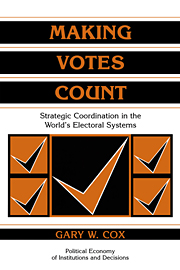Book contents
- Frontmatter
- Contents
- List of tables and figures
- Series Editors' Preface
- Preface
- PART I INTRODUCTION
- PART II STRATEGIC VOTING
- 3 On electoral systems
- 4 Strategic voting in single-member single-ballot systems
- 5 Strategic voting in multimember districts
- 6 Strategic voting in single-member dual-ballot systems
- 7 Some concluding comments on strategic voting
- PART III STRATEGIC ENTRY
- PART IV ELECTORAL COORDINATION AT THE SYSTEM LEVEL
- PART V COORDINATION FAILURES AND DEMOCRATIC PERFORMANCE
- PART VI CONCLUSION
- APPENDICES
- References
- Subject Index
- Author Index
7 - Some concluding comments on strategic voting
Published online by Cambridge University Press: 05 August 2012
- Frontmatter
- Contents
- List of tables and figures
- Series Editors' Preface
- Preface
- PART I INTRODUCTION
- PART II STRATEGIC VOTING
- 3 On electoral systems
- 4 Strategic voting in single-member single-ballot systems
- 5 Strategic voting in multimember districts
- 6 Strategic voting in single-member dual-ballot systems
- 7 Some concluding comments on strategic voting
- PART III STRATEGIC ENTRY
- PART IV ELECTORAL COORDINATION AT THE SYSTEM LEVEL
- PART V COORDINATION FAILURES AND DEMOCRATIC PERFORMANCE
- PART VI CONCLUSION
- APPENDICES
- References
- Subject Index
- Author Index
Summary
In the last three chapters, I have focused on the nature of strategic voting equilibria in the three electoral systems that featured in Duverger's original propositions: SMSP, single-tier PR, and majority runoff. The main conclusion has been that all three systems obey the M + 1 rule, according to which the number of viable candidates or lists in each system cannot exceed M + 1 (where M refers to the district magnitude for SMSP and PR, and to the number of first-round competitors who can advance to the second round for majority runoff). I have also considered three broad theoretical limits on the M + 1 result: First, if the electoral institutions do not correspond to one of those specified above, then nonstandard varieties of strategic voting may arise, that do not systematically concentrate the distribution of votes; second, even if one considers one of the electoral systems listed above, there are still a number of key assumptions about voters that must be met in order for strategic voting to have a strong effect; third, even if the electoral institutions are “right” and the voters obey all the model's assumptions, only an upper bound is imposed in Duvergerian equilibria. In this chapter, I consider the first and third of these hitherto subsidiary issues in greater detail. I make two main points. First, the fact that strategic voting only imposes an upper bound on the effective number of competitors, when it has any reductive impact at all, has some clear consequences for how we think about doing electoral research.
- Type
- Chapter
- Information
- Making Votes CountStrategic Coordination in the World's Electoral Systems, pp. 139 - 148Publisher: Cambridge University PressPrint publication year: 1997



